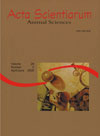<b>Meat quality of broiler chicks submeted the supplemented diets with chromium and reared in differents enviromental temperatures</b> - DOI: 10.4025/actascianimsci.v29i2.218
Abstract
Two experiments were conducted being the objective of the first experiment to evaluate the the composition of breast meat of broiler chicks fed with diets supplemented with chromium yeast (0; 400; 800 and 1,200 μg Cr kg-1) reared in different environmental temperatures (hot, thermoneutral and cold). The second experiment aimed to evaluate the quality of breast meat of broiler chicks fed with diets supplemented with chromium yeast (0 and 400 μg Cr kg-1), reared in different environmental temperatures (hot, thermoneutral and cold) and deboned in different periods (0, 5 and 24 hours). The results showed that birds reared in cold environmental temperature showed meat with lower mineral matter percentage and chromium and higher values of redness, whereas the birds reared in thermoneutral environment showed breast meat with lower moistness percentage and the birds reared in hot environmental temperature showed increase values of lightness. The supplementation of chromium presented no effect on the composition and meat quality. Whereas the increase in deboned period provided lower sarcomere length, shear force and yellowness, however higher lightness.Downloads
Download data is not yet available.
Published
2007-11-13
How to Cite
Oba, A., Souza, P. A. de, Souza, H. B. A. de, Leonel, F. R., Pelicano, E. R. L., Zeoula, N. M. B., & Bolelli, I. C. (2007). <b>Meat quality of broiler chicks submeted the supplemented diets with chromium and reared in differents enviromental temperatures</b> - DOI: 10.4025/actascianimsci.v29i2.218. Acta Scientiarum. Animal Sciences, 29(2), 143-149. https://doi.org/10.4025/actascianimsci.v29i2.218
Issue
Section
Nonruminant Nutrition
DECLARATION OF ORIGINALITY AND COPYRIGHTS
- I Declare that current article is original and has not been submitted for publication, in part or in whole, to any other national or international journal.
The copyrights belong exclusively to the authors. Published content is licensed under Creative Commons Attribution 4.0 (CC BY 4.0) guidelines, which allows sharing (copy and distribution of the material in any medium or format) and adaptation (remix, transform, and build upon the material) for any purpose, even commercially, under the terms of attribution.
Read this link for further information on how to use CC BY 4.0 properly.
0.9
2019CiteScore
29th percentile
Powered by 








































